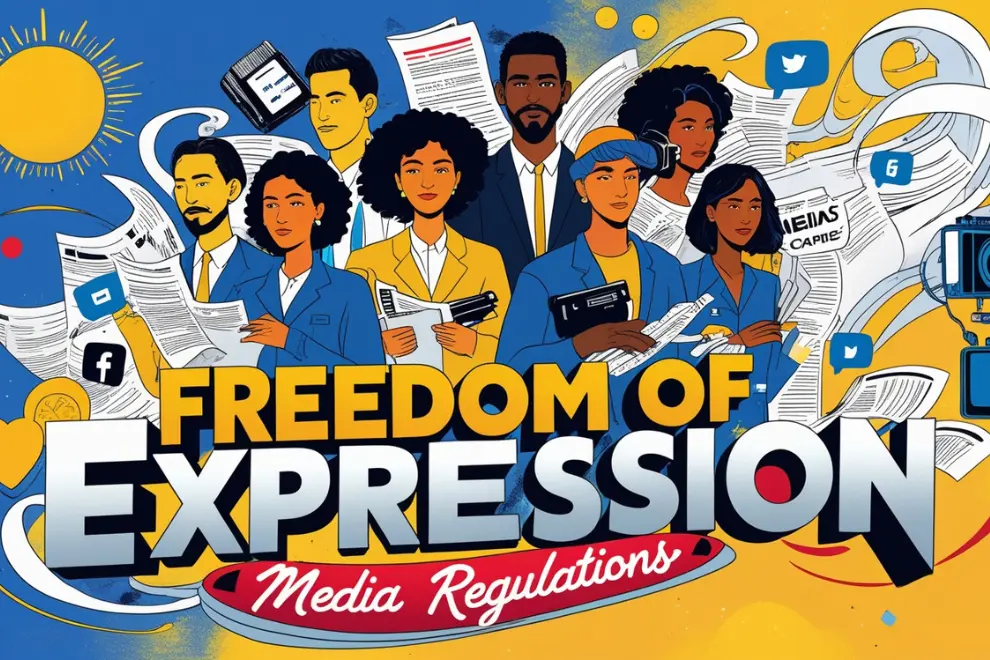Freedom of expression is a cornerstone of democracy, enabling individuals to share ideas, voice opinions, and hold those in power accountable. It empowers societies to foster creativity, debate, and progress. However, the proliferation of digital platforms and the evolving media landscape have brought new challenges, necessitating discussions on media regulations to address misinformation, hate speech, and privacy concerns. This article delves into the intricate relationship between freedom of expression and media regulations, examining the benefits, pitfalls, and ways to strike a balance.
“Freedom of Expression and Media Regulations must coexist to foster truth while safeguarding the rights of every individual.”
Understanding Freedom of Expression
Freedom of expression, enshrined in international covenants like the Universal Declaration of Human Rights (Article 19), is a fundamental right that protects individuals’ ability to seek, receive, and impart information. It underpins other rights and freedoms, enabling social and political participation, education, and access to justice.
In democratic societies, freedom of expression serves as a mechanism to:
- Promote Accountability: Citizens can critique policies, question leaders, and demand transparency.
- Foster Innovation: Open discussions pave the way for creativity and new ideas.
- Strengthen Diversity: Encouraging varied perspectives enriches cultural and intellectual discourse.
However, this right is not absolute. International frameworks also emphasize that freedom of expression comes with responsibilities, including the obligation not to incite violence, discrimination, or hatred.
The Role of Media in Modern Democracies
Media—traditional and digital—is a vehicle for exercising freedom of expression. Journalism informs the public, educates citizens, and acts as a watchdog against power abuse. Social media platforms like Twitter, Facebook, and YouTube have further democratized information dissemination, enabling individuals to voice opinions and share content on a global scale.
Nevertheless, this accessibility has a double-edged nature. While the media provides unparalleled opportunities for connectivity, it also opens the floodgates to misinformation, fake news, and harmful content. As a result, the role of media regulations in safeguarding public interest without stifling free speech has become critical.
Media Regulations: Necessity and Challenges
Media regulations encompass laws, guidelines, and practices designed to govern content dissemination, protect public order, and uphold ethical standards. They aim to:
- Combat Misinformation: False narratives and fake news can mislead the public, influence elections, and incite violence.
- Ensure Fairness: Regulations prevent monopolies and ensure balanced representation in media ownership and content.
- Protect Privacy: Safeguards are necessary to prevent unauthorized data collection and breaches.
- Mitigate Harm: Restricting hate speech, child exploitation, and glorification of violence ensures safer digital spaces.
However, implementing media regulations poses several challenges:
- Overreach: Excessive regulation can curtail free speech, leading to censorship and suppression of dissent.
- Ambiguity: Vague laws leave room for arbitrary enforcement.
- Global Disparities: Media platforms operate across borders, making consistent regulation difficult.
Freedom of Expression in the Digital Era
The advent of the internet has redefined freedom of expression. While digital platforms amplify voices, they also present unique challenges:
- Echo Chambers: Algorithms often create echo chambers, reinforcing biases and limiting exposure to diverse views.
- Cyberbullying and Harassment: Anonymity online facilitates abusive behavior, silencing vulnerable groups.
- Content Moderation: Platforms struggle to balance removing harmful content and preserving free speech.
- Surveillance: Governments and corporations may misuse technology to monitor dissent and infringe on privacy.
Case Studies: Balancing Regulations and Freedom
India: Navigating Controversial Media Laws
India’s 2021 Information Technology Rules aimed to regulate digital platforms, mandating content takedown mechanisms and appointing grievance officers. Critics argued the rules threatened press freedom and enabled state surveillance. Despite backlash, the government defended the regulations as necessary for curbing misinformation and protecting citizens.
European Union: The Digital Services Act (DSA)
The EU’s DSA represents a progressive approach to media regulation. It holds platforms accountable for removing illegal content while safeguarding freedom of expression. Transparency requirements ensure platforms disclose their algorithms, addressing concerns over biased moderation.
United States: Section 230 Debate
Section 230 of the Communications Decency Act shields online platforms from liability for user-generated content. While it fosters innovation, critics argue it allows platforms to evade accountability. Calls for reform highlight the tension between promoting free speech and preventing harm.
The Thin Line: Freedom vs. Regulation
Balancing freedom of expression and media regulation requires nuanced strategies:
- Transparent Laws: Clear, specific regulations reduce ambiguity and prevent misuse.
- Independent Oversight: Regulatory bodies must operate free from political influence to maintain credibility.
- Digital Literacy: Educating citizens about responsible online behavior can mitigate misinformation.
- Platform Accountability: Social media companies should enforce community guidelines while respecting diverse viewpoints.
- Global Cooperation: Collaborative frameworks can address cross-border challenges in media regulation.
Freedom of Expression and Media Regulations

Freedom of expression and media regulation are not mutually exclusive; they are complementary forces in a dynamic society. While safeguarding free speech is essential, unchecked dissemination of harmful content poses risks to democracy and public welfare. A balanced approach that upholds individual rights, fosters ethical media practices, and adapts to technological advancements is crucial.
By fostering transparency, accountability, and inclusivity, societies can navigate the complexities of the digital age while preserving the fundamental tenets of freedom. As we move forward, the dialogue on freedom of expression and media regulations must remain open, evolving to meet the needs of an interconnected world.


